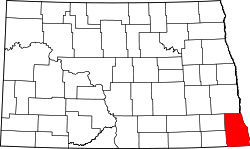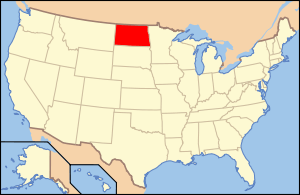Richland County, North Dakota
| Richland County, North Dakota | |
|---|---|
 Richland County Courthouse in Wahpeton | |
 Location in the U.S. state of North Dakota | |
 North Dakota's location in the U.S. | |
| Founded | November 25, 1873 |
| Seat | Wahpeton |
| Largest city | Wahpeton |
| Area | |
| • Total | 1,445 sq mi (3,743 km2) |
| • Land | 1,436 sq mi (3,719 km2) |
| • Water | 9.7 sq mi (25 km2), 0.7% |
| Population (est.) | |
| • (2015) | 16,402 |
| • Density | 11/sq mi (4/km²) |
| Congressional district | At-large |
| Time zone | Central: UTC-6/-5 |
| Website |
www |
Richland County is a county located in the U.S. state of North Dakota. As of the 2010 census, the population was 16,321.[1] Its county seat is Wahpeton.[2] The county was created by the 1872-73 territorial legislature and named for Morgan T. Rich of Wahpeton, who settled on the site of the future city in 1869. County government was organized on November 25, 1873.[3][4]
Richland County is part of the Wahpeton, ND–MN Micropolitan Statistical Area, which is also included in the Fargo-Wahpeton, ND-MN Combined Statistical Area.
Geography
According to the U.S. Census Bureau, the county has a total area of 1,445 square miles (3,740 km2), of which 1,436 square miles (3,720 km2) is land and 9.7 square miles (25 km2) (0.7%) is water.[5]
Major highways
 Interstate 29
Interstate 29 North Dakota Highway 11
North Dakota Highway 11 North Dakota Highway 13
North Dakota Highway 13 North Dakota Highway 18
North Dakota Highway 18 North Dakota Highway 27
North Dakota Highway 27 North Dakota Highway 46
North Dakota Highway 46 North Dakota Highway 127
North Dakota Highway 127
Adjacent counties
- Cass County (north)
- Wilkin County, Minnesota (east)
- Traverse County, Minnesota (southeast)
- Roberts County, South Dakota (south)
- Sargent County (west)
- Ransom County (west)
National protected area
- Sheyenne National Grassland (part)
Demographics
| Historical population | |||
|---|---|---|---|
| Census | Pop. | %± | |
| 1880 | 3,597 | — | |
| 1890 | 10,751 | 198.9% | |
| 1900 | 17,387 | 61.7% | |
| 1910 | 19,659 | 13.1% | |
| 1920 | 20,887 | 6.2% | |
| 1930 | 21,008 | 0.6% | |
| 1940 | 20,519 | −2.3% | |
| 1950 | 19,865 | −3.2% | |
| 1960 | 18,824 | −5.2% | |
| 1970 | 18,089 | −3.9% | |
| 1980 | 19,207 | 6.2% | |
| 1990 | 18,148 | −5.5% | |
| 2000 | 17,998 | −0.8% | |
| 2010 | 16,321 | −9.3% | |
| Est. 2015 | 16,402 | [6] | 0.5% |
| U.S. Decennial Census[7] 1790-1960[8] 1900-1990[9] 1990-2000[10] 2010-2015[1] | |||
2000 census
As of the census of 2000, there were 17,998 people, 6,885 households, and 4,427 families residing in the county. The population density was 12 people per square mile (5/km²). There were 7,575 housing units at an average density of 5 per square mile (2/km²). The racial makeup of the county was 96.83% White, 0.34% Black or African American, 1.66% Native American, 0.24% Asian, 0.03% Pacific Islander, 0.14% from other races, and 0.74% from two or more races. 0.68% of the population were Hispanic or Latino of any race. 46.5% were of German and 26.9% Norwegian ancestry.
There were 6,885 households out of which 32.4% had children under the age of 18 living with them, 54.2% were married couples living together, 6.5% had a female householder with no husband present, and 35.7% were non-families. 29.4% of all households were made up of individuals and 11.6% had someone living alone who was 65 years of age or older. The average household size was 2.43 and the average family size was 3.06.
In the county the population was spread out with 24.7% under the age of 18, 14.5% from 18 to 24, 25.6% from 25 to 44, 20.0% from 45 to 64, and 15.3% who were 65 years of age or older. The median age was 35 years. For every 100 females there were 107.7 males. For every 100 women age 18 and over, there were 108.6 men.
The median income for a household in the county was $36,098, and the median income for a family was $45,484. Men had a median income of $30,829 versus $20,310 for women. The per capita income for the county was $16,339. About 6.1% of families and 10.4% of the population were below the poverty line, including 7.9% of those under age 18 and 9.6% of those age 65 or over.
2010 census
As of the 2010 United States Census, there were 16,321 people, 6,651 households, and 4,171 families residing in the county.[11] The population density was 11.4 inhabitants per square mile (4.4/km2). There were 7,503 housing units at an average density of 5.2 per square mile (2.0/km2).[12] The racial makeup of the county was 95.0% white, 2.0% American Indian, 0.7% black or African American, 0.5% Asian, 0.1% Pacific islander, 0.4% from other races, and 1.3% from two or more races. Those of Hispanic or Latino origin made up 1.7% of the population.[11] In terms of ancestry, 53.0% were German, 31.2% were Norwegian, 7.0% were Irish, and 2.3% were American.[13]
Of the 6,651 households, 28.3% had children under the age of 18 living with them, 51.6% were married couples living together, 7.1% had a female householder with no husband present, 37.3% were non-families, and 30.9% of all households were made up of individuals. The average household size was 2.31 and the average family size was 2.91. The median age was 39.4 years.[11]
The median income for a household in the county was $47,131 and the median income for a family was $64,636. Males had a median income of $42,597 versus $28,284 for females. The per capita income for the county was $24,342. About 5.2% of families and 10.7% of the population were below the poverty line, including 8.8% of those under age 18 and 11.6% of those age 65 or over.[14]
Communities
Cities
Unincorporated community
Townships
- Abercrombie
- Antelope
- Barney
- Barrie
- Belford
- Brandenburg
- Brightwood
- Center
- Colfax
- Danton
- Devillo
- Dexter
- Duerr
- Dwight
- Eagle
- Elma
- Fairmount
- Freeman
- Garborg
- Grant
- Greendale
- Helendale
- Homestead
- Ibsen
- LaMars
- Liberty Grove
- Lidgerwood
- Mooreton
- Moran
- Nansen
- Sheyenne
- Summit
- Viking
- Walcott
- Waldo
- West End
- Wyndmere
See also
References
- 1 2 "State & County QuickFacts". United States Census Bureau. Retrieved November 1, 2013.
- ↑ "Find a County". National Association of Counties. Archived from the original on May 31, 2011. Retrieved 2011-06-07.
- ↑ "County History". Official Portal for North Dakota State Government. Retrieved 4 May 2011.
- ↑ "Dakota Territory, South Dakota, and North Dakota: Individual County Chronologies". Dakota Territory Atlas of Historical County Boundaries. The Newberry Library. 2006. Retrieved February 4, 2015.
- ↑ "2010 Census Gazetteer Files". United States Census Bureau. August 22, 2012. Retrieved February 1, 2015.
- ↑ "County Totals Dataset: Population, Population Change and Estimated Components of Population Change: April 1, 2010 to July 1, 2015". Retrieved July 2, 2016.
- ↑ "U.S. Decennial Census". United States Census Bureau. Archived from the original on May 11, 2015. Retrieved February 1, 2015.
- ↑ "Historical Census Browser". University of Virginia Library. Retrieved February 1, 2015.
- ↑ Forstall, Richard L., ed. (April 20, 1995). "Population of Counties by Decennial Census: 1900 to 1990". United States Census Bureau. Retrieved February 1, 2015.
- ↑ "Census 2000 PHC-T-4. Ranking Tables for Counties: 1990 and 2000" (PDF). United States Census Bureau. April 2, 2001. Retrieved February 1, 2015.
- 1 2 3 "DP-1 Profile of General Population and Housing Characteristics: 2010 Demographic Profile Data". United States Census Bureau. Retrieved 2016-04-03.
- ↑ "Population, Housing Units, Area, and Density: 2010 - County". United States Census Bureau. Retrieved 2016-04-03.
- ↑ "DP02 SELECTED SOCIAL CHARACTERISTICS IN THE UNITED STATES – 2006-2010 American Community Survey 5-Year Estimates". United States Census Bureau. Retrieved 2016-04-03.
- ↑ "DP03 SELECTED ECONOMIC CHARACTERISTICS – 2006-2010 American Community Survey 5-Year Estimates". United States Census Bureau. Retrieved 2016-04-03.
External links
- Richland County, North Dakota
- A history of Richland County and the city of Wahpeton, North Dakota (1938?) from the Digital Horizons website
 |
Cass County |  | ||
| Sargent County and Ransom County | |
Wilkin County, Minnesota | ||
| ||||
| | ||||
| Roberts County, South Dakota | Traverse County, Minnesota |
Coordinates: 46°16′N 96°57′W / 46.27°N 96.95°W